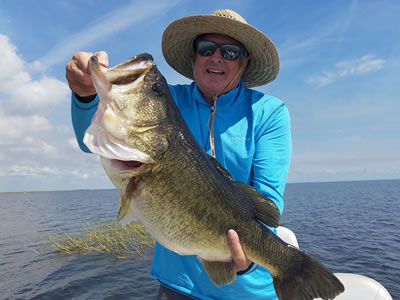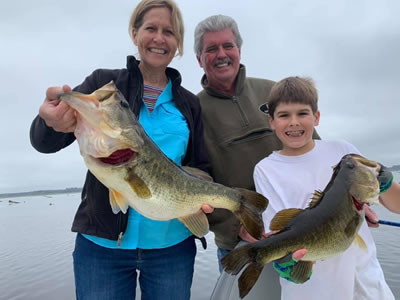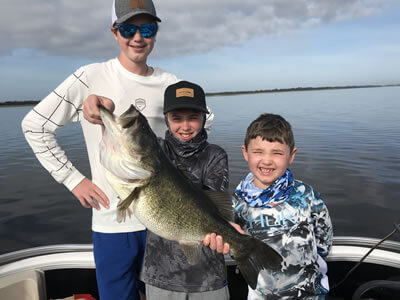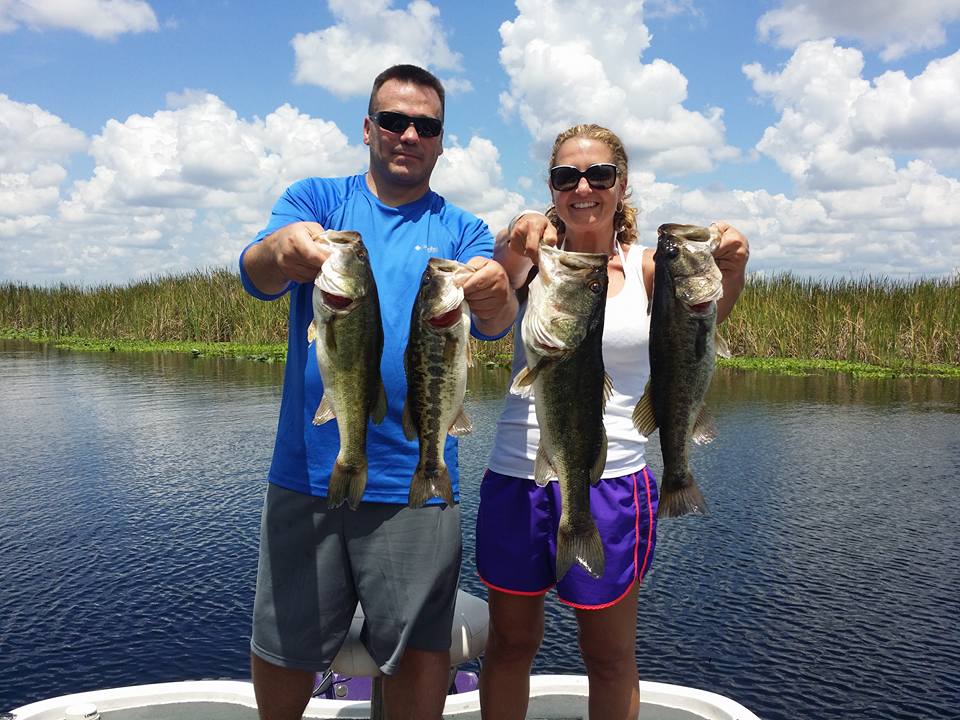Sunshine Bass
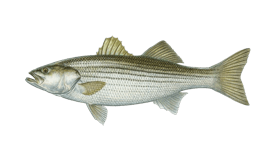
Morone chrysops (white bass) and Morone saxatilis (striped bass)
Sunshine Bass Fishing: All You Need to Know
The sunshine bass is a hatchery-produced freshwater fish crossed between a male striped bass and a female white bass. It resembles white bass in body shape but has stripes like saltwater striped bass.
They can be distinguished by irregular broken stripes on the front half of their body and straight lines on the rear half.
State hatcheries first produced sunshine bass in Florida, where they continue to be produced and stocked. This Florida hybrid gives stiff poundage competition to largemouths or similar species and has become a Holy Grail for anglers due to voracious feeding.
Fun Facts about Sunshine Bass
Does the Sunshine Bass Reproduce?
Sunshine fish are a produced bass hybrid and cannot breed on their own. In many states, such as Florida, Texas, or the Carolinas, they are spawned, reared, and released into the local lakes and rivers.
The unshine bass is related to the palmetto bass; another bass hybrid that arrived by crossing female striper eggs with the sperm of white bass males.
Each year, many lakes receive approximately 100,000 fingerlings, which can grow to four and six pounds within three years. Sunshine bass is known for their rapid growth; stocked sunshine attain six to seven pounds in weight by the age of three in optimal conditions.
Factors That Led To the Creation and Development of Sunshine Bass:
In the mid-1980s, a significant aquaculture industry emerged with hybrid striped bass production in Florida between female white bass and male striped bass. This demand arose from the diminished wild striped bass populations, whose numbers had plummeted to 450 metric tons, from 6,800 metric tons in 1973.
Most hybrid striped bass purchased by consumers are a cross between female white bass and male striped bass. Sunshine bass has high market value and is popular with Asian immigrants as they are similar to freshwater fish species from their native regions.
Until they’re one and a half months old, the bass fry or fingerlings are raised in outdoor earthen rearing ponds.
In the US, especially in the south and southeastern states, sunshine bass fingerlings are released between April and August. Many fisheries departments have increased their stock supplies, achieving year-round fingerling supply to sustain market-size fish demands.
When developing sunshine fish, the Florida Fish and Wildlife Conservation Commission had two goals in mind. One was to supplement the fisheries of existing native species, while the other was to control gizzard shad populations in lakes rich in nutrients.
In many areas, sunshine bass has served both functions in Florida, particularly in lakes and rivers containing thermal or shad refuges.
How to Fish Sunshine Bass: Essential Take-Aways for an Angler
Where Can I Find Them?
Sunshine bass is found throughout Florida, where they were produced and stocked. The sunshine bass are most active during the winter months. They prefer cold water conditions, often seeking deep lakes or feeder streams. Look for baitfish schools out in the open water of large lakes or cast in river drop-offs and other flowing water.
These fish are found as far south as Lake Ida in West Palm Beach. Prime sunshine bass fishing is done in rivers, including spillways, water outflows, and flood gates. Some of the best sunshine bass fishing is done in St. Johns, Apalachicola, and the mouth of the Escambia River.
Some places attract more sunshine bass than others, but you’ll find them stacked up in the deep holes near river sandbars. They assemble early in the morning and late evening; pickings may be slower during the day.
How to Fish Sunshine Bass: Essential Take-Aways for an Angler
Florida sunshine bass is a voracious feeder that will strike fast and hold tight. Sunshine will fight hard, coming up, running back and forth, or shaking their head. With their many directional changes and powerful turns, sunshine put up a fight that has been compared to redfish.
The easy-to-land catches can often be located in a lake and river where there are signs of nervous baitfish.
Sunshine bass will swim deep, attempting to head for open water when hooked. Don’t be in a hurry, especially if you are fishing with shiners, be gentle with the hook, and manage the bait gingerly. This is because sunshine bass has smaller mouths than native largemouth bass.
What’s the Best Bait for Sunshine Bass Fishing?
These Florida fish prefer shad as their favorite food, but they are by no means picky. Sunshines often go after live threadfin and shrimp baits too. The young fish feed more on insects and crustaceans.
Fish for sunshine bass easily with an artificial crank or spinnerbaits. They will readily bite anything that resembles small fish.
Use topwater lures, which are effective when they school near the surface; when it’s slow on the surface, troll for sunshine with artificial lures. Any artificial pattern that resembles shad is excellent for deep river holes, lakes, or spillways.
Stay prepared at all times because sunshine bass put up a spirited fight very similar to a similar sharped friend the Striper bass.
Sunshine Bass vs. Palmetto Bass: What is the Difference?
It’s a sort of misplaced science that has resulted in two remarkably versatile striped bass species. Morone chrysops (white bass) and Morone saxatilis (striped bass) are crossed to create either sunshine bass or palmetto bass.
When male striped bass sperm is spawned on female white bass eggs, the result is sunshine bass. In retrospect, female striper eggs that accept male white bass sperm develop into palmetto bass.
Sunshine and palmetto bass are nearly twins, silver and sleek, with broken stripes on their front half and straight black horizontal stripes on the rear half. Sunshine bass has a mid-body zig-zag in their lines, while the palmetto’s stripes run uninterrupted on their body.
In states like Florida, the Dakotas, and Texas, both fish’s fingerling stocks are released in hundreds of thousands in rivers and lakes.
Sunshine and palmetto bass don’t know they are sterile, and as such, perform pseudo-spawning runs upstream during a January to February migration. They both travel in schools and feed on any small fish, including gizzard shad and threadfin. The young fish eat crustaceans and mayflies, unlike the Smallmouth bass.
Make a Delicacy out of Sunshine Bass
Is Sunshine Bass Good for Eating?
Fisherfolk will find that catching this freshwater hybrid is easier than casting for black crappie or native largemouth bass.
Sunshine bass is good for eating, and it lacks the mildness or sometimes muddy flavor of native largemouth. The freshness of a river or lake the sunshine fbass was caught in will reflect in its taste.
With size and bag limits liberal in most states, you can catch sufficient sunshine bass poundage to last several meals.
Fishing for sunshine bass in the winter months, as warm waters and algal blooms can make the meat taste muddy.
Get your catch of sunshine from a clean lake, and you’ll enjoy their mild, agreeable flavor that’s been described as similar to bluegill. The raw flesh is white, and when fully cooked, it tenderizes to become flaky.
A 1.5 to 2-pound sunshine fish is probably between 15 and 18 months. Young fish tend to be tenderer than older ones, having a flaky firm filet that can be prepared with any recipe to complement your meals.
Sunshine Bass Records:
The state record for sunshine includes a 16.31-pound specimen caught on Lake Seminole in 1985, on the board of Florida and Georgia.
The world record for a sunshine fish is still the 1989 Leesville Lake, VA catch that tipped the scale at 24 pounds and 3 ounces.
WHERE CAN YOU FIND BEST CRAPPIE FISHING
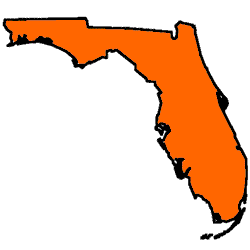
SUNSHINE BASS IN FLORIDA

SUNSHINE BASS IN MISSISSIPPI



